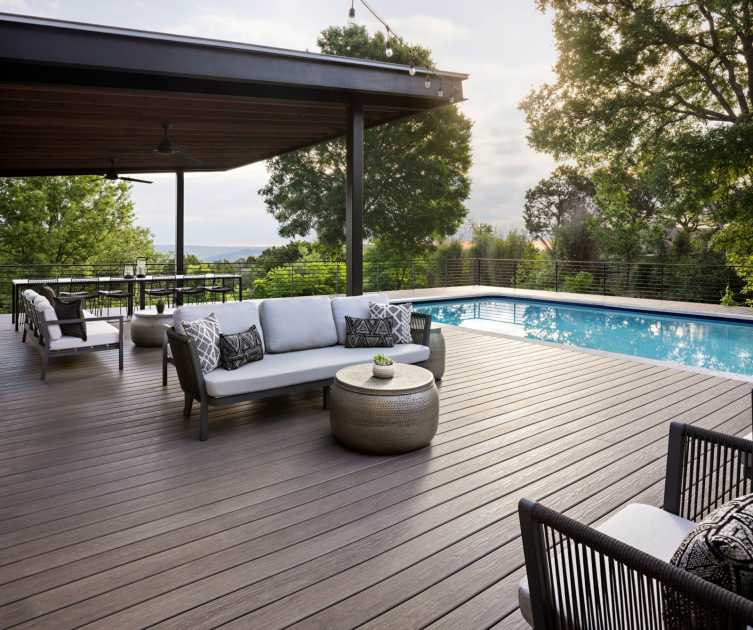Composite decking offers durability and low maintenance, while wood provides a classic, natural look. Choosing between composite decking and wood depends on your preference for longevity and aesthetics.
The decision also rests on your willingness to invest in upfront costs and allocate time for maintenance. Composite decking, made from a blend of wood fibers and recycled plastic, is praised for its durability and resistance to rot and insects.
Wood, on the other hand, offers a traditional appearance but demands regular upkeep to avoid decay and pests. The choice between composite decking and wood ultimately boils down to your priorities regarding appearance, longevity, and maintenance efforts. By weighing the pros and cons of each option, you can make an informed decision for your decking needs.

Credit: www.usqualityconstruction.com
Durability
Durability is a critical factor when choosing between composite decking and wood decking. Both options are popular, yet their durability varies, impacting the longevity and maintenance requirements of a deck. Let’s explore the different aspects of durability for composite decking and wood decking.
Composite Decking
Composite decking is engineered to be highly durable, offering excellent resistance to rot, mold, and insects. It is crafted from a blend of recycled wood fibers and plastic, resulting in a resilient and long-lasting material. Additionally, composite decking boards are designed to withstand harsh weather conditions and heavy foot traffic without warping, splintering, or fading.
Wood Decking
Wooden decks have long been a popular choice for outdoor spaces, but their durability depends on the type of wood and maintenance. Hardwood varieties like cedar, redwood, and tropical hardwoods are naturally resistant to decay and insects, lending them a higher degree of durability. However, regular maintenance, such as staining and sealing, is essential to prolong the lifespan of wood decking and prevent rot and decay.
Maintenance
Proper maintenance is essential for both composite decking and wood materials to ensure longevity and aesthetic appeal. Regular cleaning and sealing can prevent rot and decay for wood decks, while composite decking may require occasional scrubbing to remove mold and mildew.
Regular upkeep is key to preserving the look and lifespan of your outdoor deck.
Maintenance is a crucial aspect when considering whether to choose composite decking or wood. Each material requires different levels of upkeep to ensure longevity and durability.
Composite Decking
Composite decking is known for its low maintenance requirements, making it an excellent choice for homeowners looking to save time and effort.With composite decking, you won’t need to worry about staining or sealing the boards, as they are designed to resist fading, staining, and mold. Regular cleaning with soap and water is usually sufficient to keep composite decking looking its best.
Wood Decking
Wood decking, on the other hand, requires more maintenance compared to composite decking. You will need to regularly stain or seal the wood to protect it from the elements and prevent rot and decay. Debris should be promptly removed, and power washing may be necessary to keep the wood looking fresh.
In summary, if you prefer a low-maintenance option, composite decking is the way to go. For those who enjoy the natural warmth of wood but don’t mind the extra upkeep, wood decking offers a classic look. Make your choice based on your maintenance preferences and availability for upkeep tasks.
Aesthetics
When it comes to choosing between composite decking and wood decking, aesthetics play a crucial role. The appearance of your deck contributes to the overall beauty and charm of your outdoor space. Let’s take a closer look at the aesthetics of both composite and wood decking.
Composite Decking
Composite decking offers homeowners a wide range of design options. With advancements in technology, composite decking now comes in a variety of colors, textures, and finishes. Whether you prefer a natural wood look or a modern, sleek design, composite decking can fulfill your desired aesthetic. It can mimic the appearance of various wood species, allowing you to enjoy the beauty of wood without the hassle of maintenance.
Moreover, composite decking preserves its color and texture over time, making it a long-lasting choice for homeowners. The fade-resistant property of composite decking ensures that your deck will look as beautiful as the day it was installed, even after years of exposure to harsh weather conditions.
Wood Decking
If you’re looking for a classic and timeless aesthetic, consider wood decking. Wood decks have a natural warmth and beauty that many homeowners find appealing. The rich grains and unique patterns of wood lend a rustic charm to your outdoor space, creating a welcoming atmosphere for gatherings and relaxation.
Wood decking also offers the freedom to customize the appearance based on your preferences. You can choose different types of wood, such as cedar, redwood, or tropical hardwoods, each with its own distinctive color variations and grain patterns. Additionally, you have the option to stain or paint the wood to match your desired aesthetic.
However, it’s important to note that wood decking requires regular maintenance to preserve its beauty. Over time, wood decks may fade, warp, or rot if not properly treated and maintained. Therefore, those who choose wood decking should be prepared for regular upkeep to ensure the longevity and aesthetics of their deck.
| Composite Decking | Wood Decking |
|---|---|
| Wide range of colors, textures, and finishes | Classic and timeless appeal |
| Fade-resistant | Rich grains and natural warmth |
| Low maintenance | Regular maintenance required |
In summary, both composite decking and wood decking have their own unique aesthetics. Composite decking provides a wide range of design options with fade-resistant properties, while wood decking offers a timeless appeal with its natural warmth and rich grains. Consider your preferences, desired maintenance level, and the overall style of your outdoor space when choosing between these two options.
Environmental Impact
Composite decking has a lower environmental impact compared to wood decking due to its use of recycled materials, reduced maintenance requirements, and longer lifespan. It is a sustainable and eco-friendly alternative that still offers the beauty and durability of traditional wood decking.
Composite Decking
Composite decking is an eco-friendly option for decking materials that is gaining popularity due to its minimal environmental impact.
Made from a combination of recycled wood fibers and plastic, composite decking not only reduces the need for logging but also prevents the disposal of plastic waste in landfills.
This sustainable alternative to wood decking offers several advantages. Firstly, composite decking is highly durable, requiring minimal maintenance and reducing the need for replacement. Secondly, it is resistant to rot, mold, and insect damage, ensuring a longer lifespan.
Furthermore, composite decking is available in various colors and finishes, allowing homeowners to achieve their desired aesthetic while minimizing the need for toxic paints, stains, or sealants.
Wood Decking
Wood decking has long been a popular choice for outdoor spaces, but it may not be the most environmentally friendly option.
Harvesting wood for decking can contribute to deforestation, which can lead to the loss of habitats and disrupt ecosystems. Additionally, the treatment and maintenance of wood decking often involve the use of chemical preservatives that can harm the environment.
While wood is a renewable resource, using sustainable practices such as sourcing from certified forests can help mitigate its environmental impact. However, it is important to note that wood decking requires regular maintenance, including staining and sealing, to prevent rot and weathering.
Considering the environmental impact of both composite and wood decking options, composite decking emerges as the more eco-friendly choice. Its higher initial cost may be justified by its durability, low maintenance requirements, and reduced impact on natural resources.
Cost Considerations
Initial Costs
When choosing between composite decking or wood, consider the initial costs, which typically include the price of materials and installation.
- Composite decking often has a higher upfront cost than wood.
- Wood decks can be more budget-friendly initially but may require more maintenance.
Long-term Costs
Long-term costs are essential to evaluate as they encompass maintenance, repairs, and lifespan of the deck.
- Composite decking requires minimal maintenance, saving money in the long run.
- Wood decks may incur additional costs for staining, sealing, and repairs over time.
Installation Process
When it comes to installing outdoor decking, whether it’s composite decking or wood decking, the installation process is a crucial step that will determine the durability and functionality of the deck.
Composite Decking
Installing composite decking is a relatively straightforward process. It typically involves the use of concealed fasteners to create a smooth, sleek surface. The installation process mainly requires cutting the boards to size and securing them to the joists. Unlike traditional wood boards, composite decking does not require staining, sealing, or painting, which can significantly reduce the installation time.
Wood Decking
Wood decking installation involves more labor and maintenance compared to composite decking. The process begins with laying down the treated lumber joists, followed by attaching the wood boards with screws or nails. To ensure longevity, wood decking usually requires regular staining, sealing, and maintenance to protect it from the elements.
Frequently Asked Questions For Composite Decking Or Wood
Is Composite Decking Better Than Wood Decking?
Composite decking offers durability and low maintenance compared to wood decking. It resists rot, mold, and fading, providing long-term value for your outdoor space.
What Are The Benefits Of Choosing Composite Decking?
Composite decking is eco-friendly, durable, and low maintenance. It resists rotting, splintering, and fading, retaining its beauty for years without the need for staining.
How Does The Cost Of Composite Decking Compare To Wood Decking?
While initially more expensive, composite decking saves money over time due to its low maintenance and longevity. It offers a higher ROI and adds value to your property.
Conclusion
In the debate between composite decking and wood, the decision ultimately comes down to personal preference. Both options have their advantages and drawbacks, so it’s essential to consider your needs and budget. Whichever you choose, ensure proper maintenance to enjoy a beautiful and durable outdoor space.


